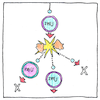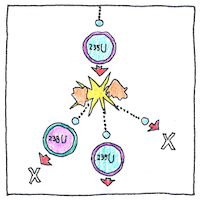Otto Hahn, Fritz Strassmann, Lise Meitner, Otto Robert Frisch, Rudolf Peierls, Enrico Fermi
physics

|
Nuclear fission
When neutrons hit uraniums split releasing neutrons and energy exponentially.
Nuclear race
In 1934, Hahn and Strassmann discovered neutrons fired into uranium produced barium. In 1939, Meitner and Frisch explained that, when split, uranium atoms release energy. In 1940, Frisch and Peierls showed how an atomic bomb could be triggered. During WW II, the U.S. feared Germany would produce the bomb. Fermi built the first self-sustaining nuclear reactor in Chicago in 1942. The U.S. hired thousands and spent billions to make the bombs dropped on Hiroshima and Nagasaki in 1945.
Nuclear murder
The bombs murdered 166,000 people in Hiroshima and 80,000 in Nagasaki from thermal radiation, falling debris, general conflagration, radiation sickness, and subsequent cancers. Most were civilians, including students from Malaya, 22,000 Korean and Chinese forced laborers, 20 Allied POWs, and 3,200 Japanese Americans.



The Fourth Geneva Convention was written in 1949, after the war, mandating the protection of non-combatants around a war zone. One would think that the United States’ moral compass would have been pointing in that direction before we dropped the bombs on Japan, and would have prevented the nuclear arms race since. The Japanese legal system has found that the bombings were illegal under international law at the time.
See also in The book of science:
Readings in wikipedia: